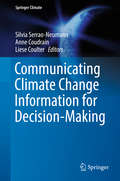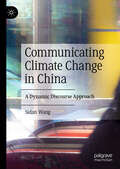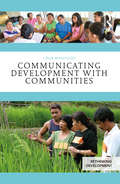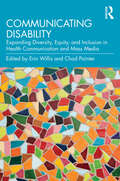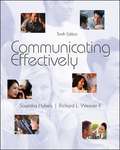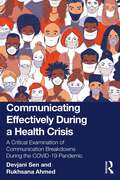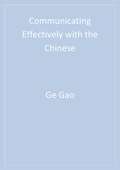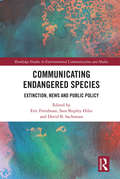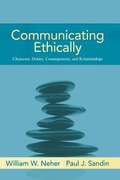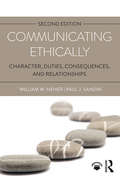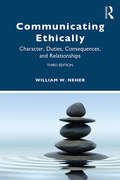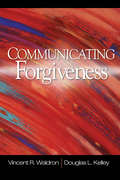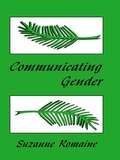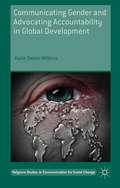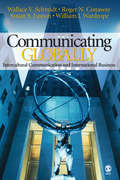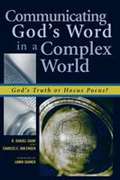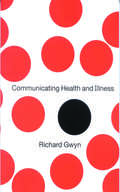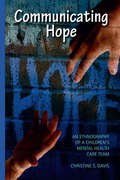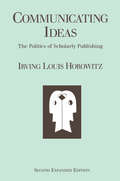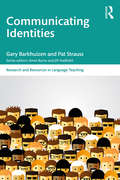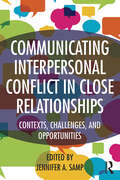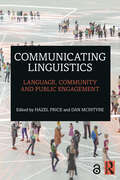- Table View
- List View
Communicating Climate Change Information for Decision-Making (Springer Climate)
by Silvia Serrao-Neumann Anne Coudrain Liese CoulterThis book provides important insight on a range of issues focused on three themes; what new climate change information is being developed, how that knowledge is communicated and how it can be usefully applied across international, regional and local scales. There is increasing international investment and interest to develop and communicate updated climate change information to promote effective action. As change accelerates and planetary boundaries are crossed this information becomes particularly relevant to guide decisions and support both proactive adaptation and mitigation strategies. Developing new information addresses innovations in producing interdisciplinary climate change knowledge and overcoming issues of data quality, access and availability. This book examines effective information systems to guide decision-making for immediate and future action. Cases studies in developed and developing countries illustrate how climate change information promotes immediate and future actions across a range of sectors.
Communicating Climate Change in China: A Dynamic Discourse Approach
by Sidan WangThis book explores how China's media narrate climate policy and climate change. With the rapid growth of economy and carbon emissions, China has been seen as having a key role in addressingclimate change and receives substantial attention from the media. In theChinese coverage, climate change issues can be interpreted as various concernsand ideas involving the dimensions of the economy, energy and emissions, publicinvolvement, science and ecology, and responsibility. In this sense, a discourseapproach can be used to understand how the newspapers construct the climatechange discourse and discourse networks in the coverage. This study selectsthree different newspapers in China, namely People’sDaily, China Daily and Southern Weekend. This book will interest scholars of Chinese politics, environmentalists, and media studies scholars.
Communicating Development with Communities (Rethinking Development)
by Linje ManyozoDevelopment theory and practice are often taught in a manner that strips them of their historical context and obscures alternative intellectual assumptions and critical frameworks. This prevents students from acquiring a holistic understanding of the world and consequently, when it comes to development practice, most lack the skills to live and engage with people. It has become crucial to properly consider what it means to conceive and implement participatory development out in the field and not just in the boardroom. Building on the work of Robert Chambers and Arturo Escobar, Communicating Development with Communities is an empirically grounded critical reflection on how the development industry defines, imagines and constructs development at the implementation level. Unpacking the dominant syntax in the theory and practice of development, the book advocates a move towards relational and indigenous models of living that celebrate local ontologies, spirituality, economies of solidarity and community-ness. It investigates how subaltern voices are produced and appropriated, and how well-meaning experts can easily become oppressors. The book propounds a pedagogy of listening as a pathway that offers a space for interest groups to collaboratively curate meaningful development with and alongside communities. This is a valuable resource for academics and practitioners in the fields of Development Studies, Communication for Development, Communication for Social Change, Social Anthropology, Economic Development and Public Policy. Foreword by Robin Mansell.
Communicating Differences: Culture, Media, Peace and Conflict Negotiation
by Sudeshna Roy Ibrahim ShawThis volume captures the essence of how we communicate differences in relationships, between and across cultures, in organizations, through education and in moments of local and global conflict and crisis that demonstrates the importance and viability of approaching peace and conflict communication from various fields within communication studies.
Communicating Disability: Expanding Diversity, Equity, and Inclusion in Health Communication and Mass Media
by Chad Painter Erin WillisThis book enables readers to confidently discuss and understand disability as part of the broader societal conversation on diversity, equity, and inclusion.The influence of mass media can raise awareness, educate, reduce stigma, facilitate advocacy related to disability, and activate attitude and behavior change. Recognizing that disability is a complex, multi-dimensional topic, this book presents case studies, original research, and practical applications related to society and cultural events about disability to highlight prominent issues related to diversity, equity, and inclusion initiatives. While previous work examined disability through activism or historical lenses, this book explores contemporary industry practices and how current conversations are driving trends in the field. Divided into three parts related to journalism and news reporting, strategic communication, and health communication, the book provides readers with the knowledge and skills to create conversation that gives space to disability and facilitates advancement in inclusion.Filling a void in disability literature, this book will be of interest to scholars as well as undergraduate and graduate students in the fields of health communication, journalism, strategic communication, media studies, disability studies, public health, and medical sociology.
Communicating Effectively (10th Edition)
by Saundra Hybels Richard L. Weaver IICommunicating Effectively, Tenth Edition, presents the foundations of communication theory and provides many opportunities for skill building practice. Using a pragmatic approach with numerous examples from the classroom, workplace, and community, students will learn to appreciate the practical application of the ideas, concepts, and theories in their own lives and in the lives of people close to them.
Communicating Effectively During a Health Crisis: A Critical Examination of Communication Breakdowns During the COVID-19 Pandemic
by Rukhsana Ahmed Devjani SenExploring how and why communication breakdowns occur during pandemics and world disasters, this book offers solutions for improving communication and managing future public health crises.A compilation of evidence-based lessons learned, this book shows how to effectively convey critical lifesaving information during a pandemic. It assesses how trust in leaders and governments during a public health crisis is formed and the impact this has on how information is perceived by the public. Using the COVID-19 pandemic as a case study, the book demonstrates how informative policy decisions and health risk messages can be better communicated for the handling of future pandemics. At a macro-level, the book looks at issues concerning situational awareness, how different countries managed or mismanaged the pandemic, and the lessons readers can learn from those occurrences. At a micro-level, it examines individual differences in public health message perceptions and corresponding actions taken or not taken.An interdisciplinary critique of the delivery and reception of messages during global disasters, this text is suitable for undergraduate and graduate courses in Communication Studies, Health Communication, Risk Communication and Public Health, Psychology, Sociology, and Disaster Management.
Communicating Effectively with the Chinese
by Ge Gao Dr Stella Ting-ToomeyUtilizing the `self-OTHER' perspective as a conceptual foundation, the authors portray and interpret some of the distinctive communication practices in Chinese culture. They examine how self-conception, role and hierarchy, relational dynamics and face affect ways of conducting everyday talk in Chinese culture. They explain why miscommunication between Chinese and North Americans takes place and suggest ways to improve communication. By incorporating instances of everyday talk, the authors offer a realistic and clear illustration of the specific characteristics and functions of Chinese communication, as well as problematic areas of Chinese//North American encounters.
Communicating Endangered Species: Extinction, News and Public Policy (Routledge Studies in Environmental Communication and Media)
by Eric Freedman; Sara Shipley Hiles; David B. SachsmanCommunicating Endangered Species: Extinction, News, and Public Policy is a multidisciplinary environmental communication book that takes a distinctive approach by connecting how media and culture depict and explain endangered species with how policymakers and natural resource managers can or do respond to these challenges in practical terms. Extinction isn’t new. However, the pace of extinction is accelerating globally. The International Union for Conservation of Nature classifies more than 26,000 species as threatened. The causes are many, including climate change, overdevelopment, human exploitation, disease, overhunting, habitat destruction, and predators. The willingness and the ability of ordinary people, governments, scientists, nongovernmental organizations, and businesses to slow this deeply disturbing acceleration are uncertain. Meanwhile, researchers around the world are laboring to better understand and communicate the possibility and implications of extinctions and to discover effective tools and public policies to combat the threats to species survival. This book presents a history of news coverage of endangered species around the world, examining how and why journalists and other communicators wrote what they did, how attitudes have changed, and why they have changed. It draws on the latest research by chapter authors who are a mix of social scientists, communication experts, and natural scientists. Each chapter includes a mass media and/or cultural aspect. This book will be essential reading for students, natural resource managers, government officials, environmental activists, and academics interested in conservation and biodiversity, environmental communication and journalism, and public policy.
Communicating Ethically
by Paul Sandin William NeherCommunication Ethics provides a broad introduction to the ethical nature of communication. The book combines coverage of the major systems of ethical reasoning with lots of applications, including case studies in each chapter, to investigate ethics within many fields in the discipline: rhetoric, interpersonal communication, organizational communication, political communication, and mass communication/media. By incorporating a simple framework for ethical reasoning, the reader will be able to develop their own understanding of the various criteria for making ethical judgments.
Communicating Ethically: Character, Duties, Consequences, and Relationships
by Paul Sandin William NeherCommunicating Ethically provides a broad introduction to the ethical nature of communication. Now in its second edition, the text has been revised to further address current issues, such as: evolving social media and digital platforms, growing cultural communication and discussion of diversity, and the ethics of public discourse. This book combines coverage of the major systems of ethical reasoning with applications, including case studies in each chapter, to investigate ethics within many fields in the communication discipline. Incorporating a simple framework for ethical reasoning allows the reader to develop their own understanding of the various criteria for making ethical judgments.
Communicating Ethically: Character, Duties, Consequences, and Relationships
by William W. NeherThis thoroughly updated third edition of Communicating Ethically provides a broad introduction to the ethical nature of communication, bringing together classical and modern theories of ethical philosophy to address issues at play in specific careers and domains throughout the field. By incorporating a simple framework for ethical reasoning, the reader will be able to develop their own understanding of the various criteria for making ethical judgments. Communicating Ethically applies ethical theories such as virtue ethics and dialogic ethics to contexts of interpersonal, organizational, political, and digital communication. This edition contains expanded coverage of contemporary and non-Western theories and contexts, including Black Lives Matter, #MeToo, social media and "fake news," and concerns of inclusion and marginalization. Each chapter contains a Preview and Key Ideas sections, and the book contains a Glossary. This book serves as core textbook for undergraduate courses in communication and media ethics, and can also serve as a supplemental resource for field-specific courses in Strategic Communication, Interpersonal Communication, and Public Relations. Online resources for instructors include sample syllabi, sample assignments, and quiz questions. They are available at www.routledge.com/9780367358471.
Communicating Forgiveness
by Vincent R. Waldron Dr Douglas L. KelleyCommunicating Forgiveness is the first book to take a truly communicative look at the process of forgiveness. Authors Vincent R. Waldron and Douglas L. Kelley provide a synthesis of the literature on forgiveness in relationships. Grounded in real-life forgiveness narratives, this interdisciplinary text (pulling from such related fields as psychology, counseling, family studies, peace studies, conflict management, religious studies, and organizational behavior) offers a hopeful framework for negotiating healthy and just responses to relational disappointments.
Communicating Gender
by Suzanne RomaineTaking a cross-disciplinary approach, Suzanne Romaine's main concern is to show how language and discourse play key roles in understanding and communicating gender and culture. In addition to linguistics--which provides the starting point and central focus of the book--she draws on the fields of anthropology, biology, communication, education, economics, history, literary criticism, philosophy, psychology, and sociology. The text covers the "core" areas in the study of language and gender, including how and where gender is indexed in language, how men and women speak, how children acquire gender differentiated language, and sexism in language and language reform. Although most of the examples are drawn primarily from English, other European languages and non-European languages, such as Japanese are considered. The text is written in an accessible way so that no prior knowledge of linguistics is necessary to understand the chapters containing linguistic analysis. Each chapter is followed by exercises and discussion questions to facilitate the book's use as a classroom text. The author reviews scholarly treatments of gender, and then uses her own data material from the corpora of spoken and written English usage. Special features include an examination of contemporary media sources such as newspapers, advertising, and television; a discussion of women's speculative fiction; a study of gender and advertising, with special attention paid to the role played by language in these domains; and a review of French feminist thought, particularly as it relates to the issue of language reform.
Communicating Gender and Advocating Accountability in Global Development (Palgrave Studies in Communication for Social Change)
by Karin WilkinsCase studies of micro-enterprise, girls' education, and population programs suggest that our discourse limits our potential to conceive of development, communication, and gender outside of neoliberal ideologies. Advocacy for global social justice demands a different accountability through critical research.
Communicating Globally: Intercultural Communication and International Business
by Wallace V. Schmidt Roger N. Conaway Susan S. Easton William J. WardropeCommunicating Globally: Intercultural Communication and International Business uniquely integrates the theory and skills of intercultural communication with the practices of multinational organizations and international business. Authors Wallace V. Schmidt, Roger N. Conaway, Susan S. Easton, and William J. Wardrope provide students with a cultural general awareness of diverse world views, valuable insights on understanding and overcoming cultural differences, and a clear path to international business success.
Communicating God's Word In A Complex World: God's Truth Or Hocus Pocus?
by Charles E. Van Engen Lamin Sanneh R. ShawCommunicating God's Word in a Complex World reaches out to the growing number of missionaries, pastors, Bible translators and teachers, mission and theological educators and students dealing with communicating the gospel. This is increasingly difficult in today's pluralist and global contexts. What was God's message, and how has spreading that message changed through the generations? The answer to that question requires a hermeneutical process that seeks to understand the biblical text and the context in which it was originally presented. R. Daniel Shaw and Charles Van Engen say that contemporary proclaimers of God's word can model their approach after that of the writers of scripture, who reinterpreted and restated their received texts for their audiences. Thus, Gospel communication is impacted by the way humans know God. This, in turn, is informed by contexts. Communicating God's Word in a Complex World draws lessons from the biblical authors themselves as a guide for how best to present God's message.
Communicating Health and Illness
by Dr Richard Gwyn`There has been a pressing need for a book like this for some time. Gwyn cogently reviews the literature on discourse analysis as it pertains to medical and health matters. Introducing original research from his own studies allows him to vividly illustrate just how important it is to understand the role played by discourse. Students of health communication and the sociology of health and illness will find this book integral to their studies' - Deborah Lupton In this book, Richard Gwyn demonstrates the centrality of discourse analysis to an understanding of health and communication. Focusing on language and communication issues he demonstrates that it is possible to observe and analyze patterns in the ways in which health and illness are represented and articulated by both health professionals and lay people. Communicating Health and Illness: Explores culturally validated notions of health and sickness and the medicalization of illness. Surveys media representations of health and illness Considers the metaphoric nature of talk about illness Contributes to the ongoing debate in relation to narrative based medicine.
Communicating Hope: An Ethnography of a Children's Mental Health Care Team
by Christine DavisKevin is a sometimes-violent teenager with severe emotional disturbance in a family environment of poverty and stress. In this ethnography of a children's mental health care team, communication scholar Christine S. Davis delves deeply into how members of the team create hope for themselves, for Kevin, and for his family using a strengths orientation and future focus. A rich, evocative narrative that highlights multiple voices and interpretations, Davis provides a multilayered study of how social service workers can motivate and heal troubled families in challenging environments. The volume includes clinical and practice considerations for those working in the social welfare system
Communicating Human and Non-Human Otherness: Urban Culture, Technology and Post-Humanism (Palgrave Studies in Otherness and Communication)
by Luísa Magalhães Helena Pires Zara Pinto-CoelhoThis book approaches the generic theme of the series – studies in otherness and communication – from the perspectives of urban culture and posthumanist studies. It brings together a broad variety of essays examining the different ways in which agency reinvents itself, whether in the urban space, through the multiple forms and devices of art and culture, or through the relationship with technology and the surrounding environment, as a result of the contemporary conditions of post-humanism and the anthropocene. The sense of becoming other is added through a new paradigm that combines 1) a theoretical-essayistic mode, supported by illustrative cases with 2) the description of artistic processes and literary production. The essays are written by an international group of humanities and social sciences scholars/artists, consisting of Cristina Álvares, Pier Luca Marzo, Edwige Armand, Chiara Mengozzi, Ricardo G. Soeiro, Panagiotis Ferentinos, Mónica Aubán Borrell, Luis Campos Medina, Bill Psarras, Cíntia Sanmartin Fernandes, Micael Herschmann, Mitja Velikonja, Teresa Mora and Tiago Porteiro.
Communicating Ice through Popular Art and Aesthetics (Palgrave Studies in Media and Environmental Communication)
by Anna-Sophie Jürgens Anne HemkendreisThis book brings together the perspectives of eminent and emerging scholars from fields as varied as science communication, art history, pop cultural studies, environmental studies, sciences studying ice and artists to explore the power of (popular) arts and aesthetics to communicate ice research and the urgency of environmental action. Examining the aesthetic strategies employed in images, (popular) visual fiction and narratives to convey meaning and awareness – and how they can be made fruitful for science communication – the project will generate new perspectives on how our collective environmental responsibility can be addressed and communicated across disciplines and divers audiences. In doing so, the volume will illuminate the cultural power of ice research and contribute to a better understanding of the cultural work that emerges from our ecological crisis.
Communicating Ideas: The Politics of Scholarly Publishing
by Irving Louis HorowitzCommunicating Ideas is the first attempt to place publishing in America in its political and commercial setting. The book addresses the political implications of scholarly communication in the era of the new computerized technology. Horowitz does so by examining classic problems of political theory in the context of property rights versus the presumed right to know, and the special strains involved in publishing as a business versus information as a public trust Offering a knowledgeable and insightful view of publishing in America and abroad, this book makes an important contribution to the study of mass culture in advanced societies.The discussion ranges considerably beyond scholarly publications into communication as a whole, encompassing a wide range of issues from cable and satelite television control to specialized issues in copyright legislation, the prize system in publishing, and the definition of standards of the industry. This new edition, expanded by fully one third, expands on such themes, and in addition deals with Horowitz's new research on the history of social science publishing.The first edition, published in 1986, was described by WE. Coleman as "a marvelous book which indeed offers a realistic analysis of publishing." John P. Dessauer declared that "no one thinking seriously about the future of scholarly communication can afford to ignore his work, in particular his treatment of basic issues." Joseph Gusfield (Los Angeles Times), in his review, noted that "Horowitz is alive to the possibilities and barriers for academics to reach a wider audience and for lay persons to utilize scholarship. Both groups can learn much from this intelligent book." And Philip G. Altbach (Scholarly Publishing) concluded his review by saying that Communicating Ideas "will be of interest not only to publishers and editors, but also to librarians and to sociologists of science."
Communicating Identities (Research and Resources in Language Teaching)
by Gary Barkhuizen Pat StraussCommunicating Identities is a book for language teachers who wish to focus on the topic of identity in the context of their classroom teaching. The work provides an accessible introduction to research and theory on language learner and language teacher identity. It provides a set of interactive, practical activities for use in language classrooms in which students explore and communicate about aspects of their identities. The communicative activities concern the various facets of the students’ own identities and are practical resources that teachers can draw on to structure and guide their students’ exploration of their identities. All the activities include a follow-on teacher reflection in which teachers explore aspects of their own identity in relation to the learner identities explored in the activities. The book also introduces teachers to practical steps in doing exploratory action research so that they can investigate identity systematically in their own classrooms.
Communicating Interpersonal Conflict in Close Relationships: Contexts, Challenges, and Opportunities
by Jennifer A. SampCommunicating Interpersonal Conflict in Close Relationships: Contexts, Challenges, and Opportunities provides a state-of-the-art review of research on conflict in close personal relationships. This volume brings together both seasoned and new voices in communication research to address the challenges in evaluating conflict. Contributors review the current state of research on themes related to power, serial arguments, interpersonal and family dynamics, physiological processes, and mechanisms of forgiveness by presenting theoretical reviews, original unpublished data-driven research, and discussions about the methodological challenges and opportunities in studying interpersonal conflict. An essential resource for graduate students and faculty interested in interpersonal conflict in close relationships between romantic partners, families, or friends, this volume is intended for advanced coursework and individual study in communication, social psychology, and close relationship scholarship.
Communicating Linguistics: Language, Community and Public Engagement
by Hazel Price and Dan McIntyreIncreasingly, academics are called upon to demonstrate the value of linguistics and explain their research to the wider public. In support of this agenda, Communicating Linguistics: Language, Community and Public Engagement provides an overview of the wide range of public engagement activities currently being undertaken in linguistics, as well as practically focused advice aimed at helping linguists to do public engagement well. From podcasts to popular writing, from competitions to consultancy, from language creation to community projects, there are many ways in which linguists can share their research with the public. Bringing together insights from leading linguists working in academia as well as non-university professions, this unique collection: Provides a forum for the discussion of challenges and opportunities of public engagement in linguistics in order to shape best practice Documents best practice through a summary of some of the many excellent public engagement projects currently taking place internationally Celebrates the long tradition of public engagement in linguistics, a discipline which is often misunderstood despite its direct and fundamental importance to everyday life Breaking down long-standing divisions between universities and the wider community, this book will be of significant value to academics in linguistics but also teachers, policy makers and anyone interested in better understanding the nature and use of language in society. Creative Commons Attribution-Non Commercial-No Derivatives 4.0 license.
